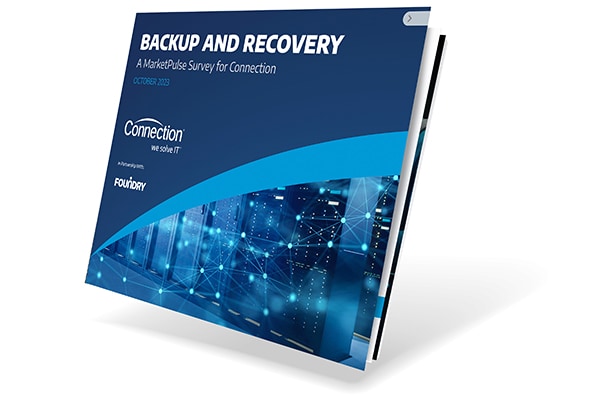
Organizations are dependent on data to fuel innovation, decision-making, and competitive advantage. But protecting this data is no easy task.
To understand how well organizations are doing, we partnered with Foundry in surveying 100 U.S.-based senior IT decision-makers on their organization’s data backup and recovery strategies. The study digs into not only data storage methods and the frequency of testing backup data integrity but what factors influenced the decision-making process when choosing backup service and software.
What we found is that the struggle to protect data is real and significant. Almost all organizations (91%) said they had experienced data loss firsthand, with 85% of these incidents occurring in the past year. These figures underscore the urgency for every organization to have robust data backup and recovery plans in place.
To understand how well organizations are doing, we partnered with Foundry in surveying 100 U.S.-based senior IT decision-makers on their organization’s data backup and recovery strategies. The study digs into not only data storage methods and the frequency of testing backup data integrity but what factors influenced the decision-making process when choosing backup service and software.
What we found is that the struggle to protect data is real and significant. Almost all organizations (91%) said they had experienced data loss firsthand, with 85% of these incidents occurring in the past year. These figures underscore the urgency for every organization to have robust data backup and recovery plans in place.
Data Loss Concerns Continue to Grow
Not only have the vast majority of organizations experienced a data loss incident, but most IT decision-makers (85%) still harbor concerns about the potential loss of critical data within the upcoming year. Nearly half (48%) of respondents indicated they were “very concerned,” and 37% were “somewhat” concerned.While data loss can originate from a variety of sources—natural disasters, power outages, or hardware or software failures—cyberattacks were the leading cause, accounting for 59% of incidents. Human error (57%) and system failures (55%) came in second and third, respectively.
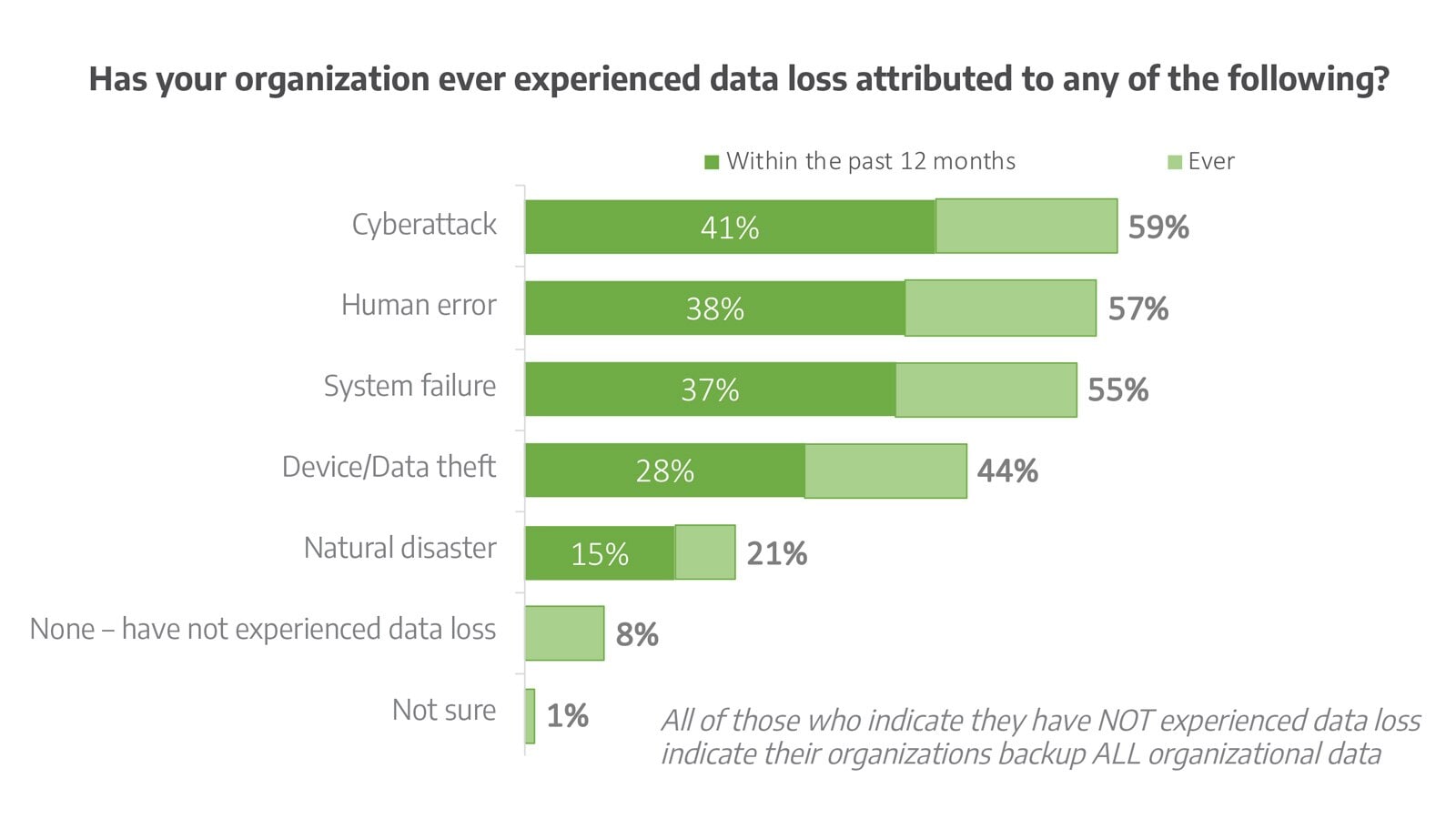
However, despite the increasing risk of data loss, one-third (33%) of organizations have not evaluated their backup and recovery strategy in the past six months. Another 26% evaluated their plan six months to two years ago, while 7% indicated their strategy was last evaluated more than two years ago. Two-thirds (66%) have reviewed their plan in the past six months.
Frequent review and evaluation of backup and recovery plans is necessary because the potential threats and technology landscape are constantly evolving. Organizations that wait longer than six months to reevaluate their strategy may be vulnerable to new risks. They may also be missing out on technological advancements that could impact the effectiveness of their backup protocols.
Frequent review and evaluation of backup and recovery plans is necessary because the potential threats and technology landscape are constantly evolving. Organizations that wait longer than six months to reevaluate their strategy may be vulnerable to new risks. They may also be missing out on technological advancements that could impact the effectiveness of their backup protocols.
The Impact of a Data Loss Incident Is Severe
Three-quarters (75%) of those who have experienced data loss reported a strong to severe impact on overall security posture, and 66% reported a similar impact on productivity. More than half (55%) indicated finances/expenses have been strongly or severely impacted by data loss.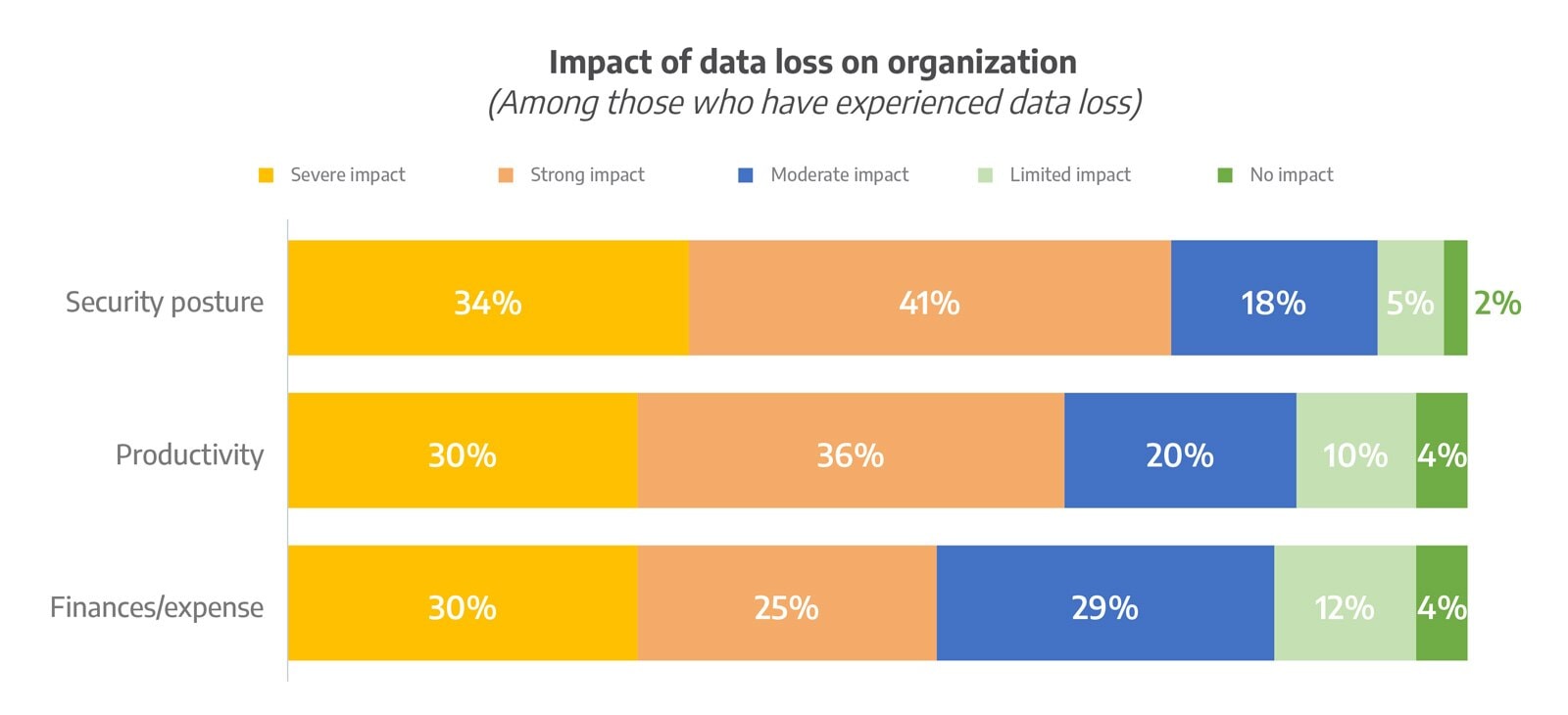
These impacts can manifest in a myriad of ways, such as the cost of recovery efforts, potential legal liabilities if customer data is exposed, loss of revenue due to downtime, or damage to the organization’s reputation. Productivity can also be significantly hampered when vital data is lost. Employees that need the data to do their jobs effectively and efficiently may be unable to do so and would instead need to spend time and effort to reconstruct lost data. This not only hampers productivity at the moment but can potentially result in missed revenue targets, delayed project deliveries, and a less-than-optimal customer experience if the data loss results in an external impact on customers.
Backup and Recovery Planning to Avoid Data Loss
With nearly every organization affected by data loss incidents, most aren’t taking any chances when it comes to protecting their data. The majority of organizations (55%) have opted for a comprehensive approach, backing up all organizational data. This strategic choice reflects a proactive stance towards data protection, ensuring that no critical information is left vulnerable.Conversely, 18% adopt a more targeted approach by focusing solely on mission-critical data. This more selective approach allows organizations to allocate resources efficiently while still safeguarding the most vital information.
When it comes to storage approaches, 93% of organizations are leveraging cloud and hybrid storage solutions for their backup data, with 49% using hybrid storage and 44% storing backup data in the cloud.
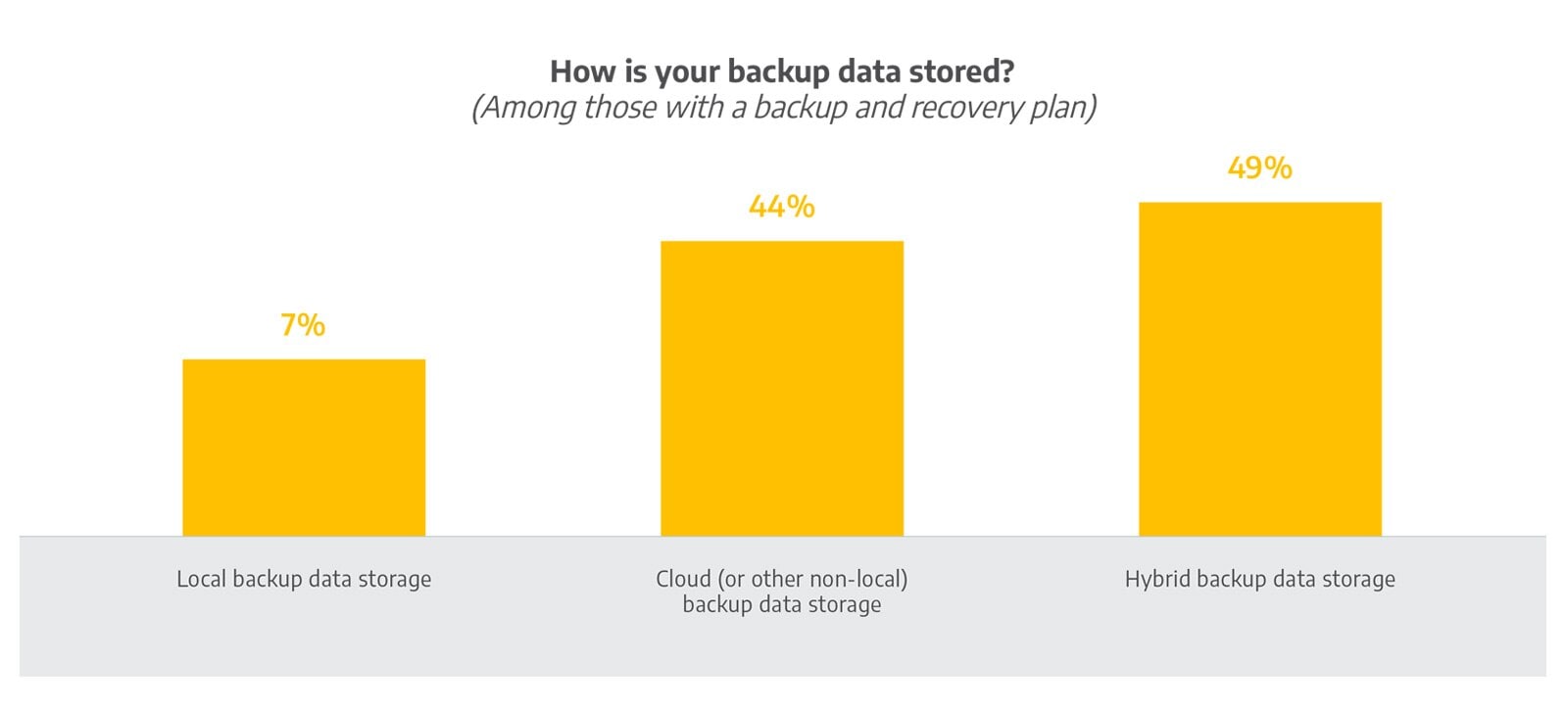
This shift towards cloud-based solutions can be attributed to the numerous advantages the cloud offers, including scalability, cost-effectiveness, and accessibility. Cloud storage also provides an offsite location for data storage, reducing the risk of physical damage or loss due to any on-premise incidents. As for hybrid storage solutions, they offer a balanced approach that ensures data availability through on-premise storage while also keeping data secure offsite in the cloud.
Routine and frequent data integrity checks are also an essential component of any proactive backup and recovery strategy. While 55% of organizations surveyed conduct these data integrity checks routinely and frequently, one-fifth of organizations (20%) perform these checks on a routine but limited basis, potentially leaving room for gaps in data integrity. Another quarter of organizations (23%) check data integrity only occasionally, indicating a need for greater diligence in ensuring the quality and reliability of backup data.
Routine and frequent data integrity checks are also an essential component of any proactive backup and recovery strategy. While 55% of organizations surveyed conduct these data integrity checks routinely and frequently, one-fifth of organizations (20%) perform these checks on a routine but limited basis, potentially leaving room for gaps in data integrity. Another quarter of organizations (23%) check data integrity only occasionally, indicating a need for greater diligence in ensuring the quality and reliability of backup data.
Choosing the Right Backup and Recovery Solutions
When it comes to selecting a backup service or software, organizations weigh several critical factors to ensure their data is safeguarded effectively. Our survey revealed that the top priority for decision-makers is the security and encryption capabilities offered by the backup service, with 52% of respondents emphasizing this aspect.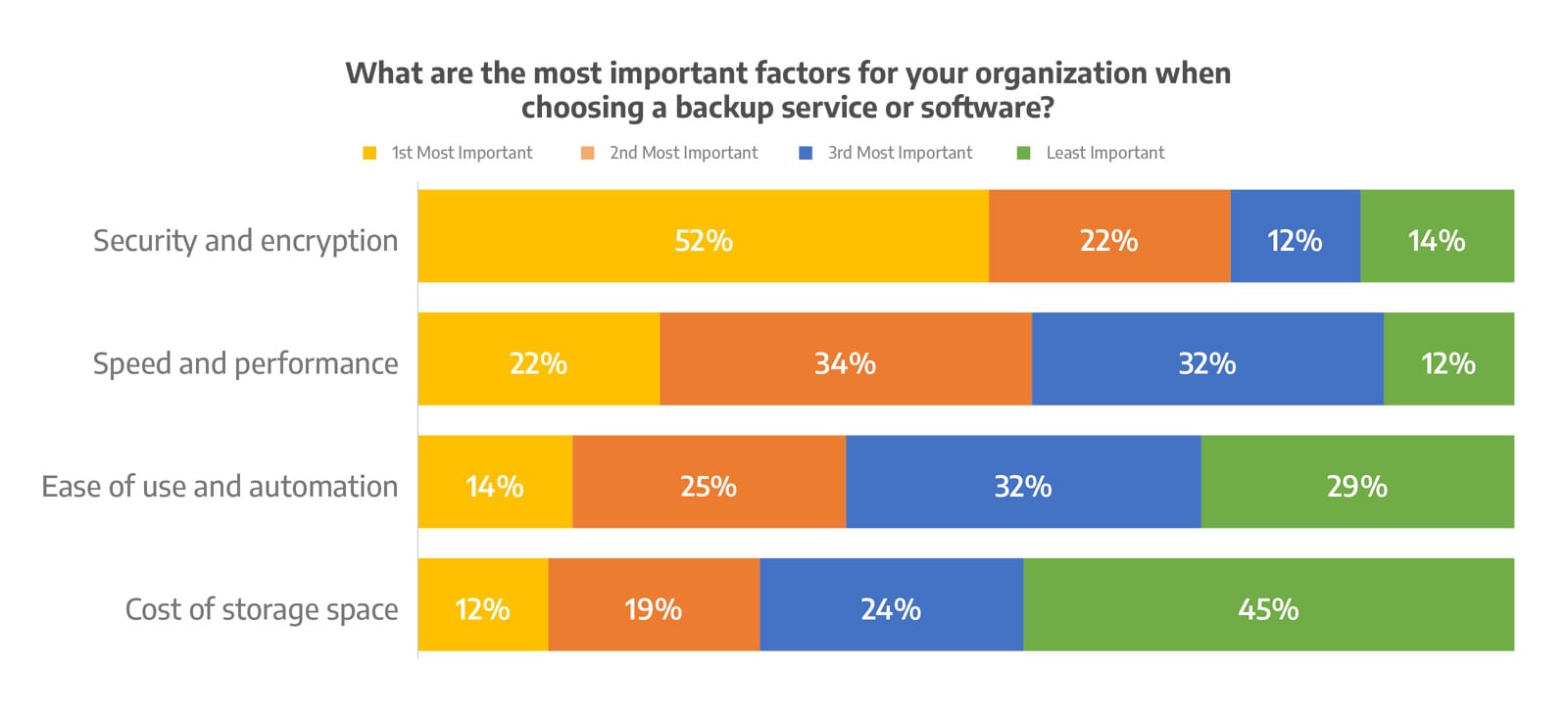
In an era marked by an escalating threat landscape, it’s not surprising that organizations prioritize the protection of their sensitive information. Robust encryption protocols and secure storage solutions are paramount in instilling confidence that data remains shielded from unauthorized access or cyber threats.
Another significant consideration in backup service selection is speed and performance, as indicated by 22% of respondents. This factor is particularly crucial for organizations with high data volumes or stringent recovery time objectives (RTOs). Ensuring that backups can be completed swiftly and efficiently and that data can be restored promptly is vital for maintaining operational continuity and minimizing potential downtime in the event of a data loss.
Ease of use and automation also emerged as a noteworthy factor, garnering the attention of 14% of surveyed IT decision-makers. Streamlined, user-friendly interfaces and automation capabilities can significantly enhance the efficiency of backup processes. By simplifying the setup, monitoring, and management of backups, organizations can reduce the burden on IT teams and ensure that backup protocols are consistently executed without manual intervention. This not only improves operational efficiency but also minimizes the potential for human error in the backup process.
Finally, the cost of storage space was highlighted by 12% of respondents as a crucial consideration in backup service selection. Balancing the need for adequate storage capacity with budget constraints is a common challenge for organizations. Cost-effective storage solutions that provide scalability and flexibility are favored, allowing organizations to adapt their backup strategies to evolving data requirements without incurring exorbitant expenses or compromising the integrity or security of stored data.
Another significant consideration in backup service selection is speed and performance, as indicated by 22% of respondents. This factor is particularly crucial for organizations with high data volumes or stringent recovery time objectives (RTOs). Ensuring that backups can be completed swiftly and efficiently and that data can be restored promptly is vital for maintaining operational continuity and minimizing potential downtime in the event of a data loss.
Ease of use and automation also emerged as a noteworthy factor, garnering the attention of 14% of surveyed IT decision-makers. Streamlined, user-friendly interfaces and automation capabilities can significantly enhance the efficiency of backup processes. By simplifying the setup, monitoring, and management of backups, organizations can reduce the burden on IT teams and ensure that backup protocols are consistently executed without manual intervention. This not only improves operational efficiency but also minimizes the potential for human error in the backup process.
Finally, the cost of storage space was highlighted by 12% of respondents as a crucial consideration in backup service selection. Balancing the need for adequate storage capacity with budget constraints is a common challenge for organizations. Cost-effective storage solutions that provide scalability and flexibility are favored, allowing organizations to adapt their backup strategies to evolving data requirements without incurring exorbitant expenses or compromising the integrity or security of stored data.
A Robust Backup and Recovery Plan Is Essential
The need for data backup and recovery is more critical than ever before. The prevalence of data loss incidents across almost every organization illustrates the necessity and urgency for robust backup and recovery planning.The future of backup and recovery practices is likely to witness continued advancements in technology, including enhanced automation, artificial intelligence-driven insights, and even more sophisticated security protocols. As organizations continue to grapple with an evolving digital landscape, staying abreast of these trends will be crucial in fortifying data protection strategies and ensuring resilience in the face of unforeseen challenges.
Interested in learning more about how Connection can help you improve your backup and recovery strategy? Reach out to your Account Team for more information.
Additional Backup and Recovery Planning Resources
Countering Ransomware Attacks
Businesses must make protecting their data from a ransomware attack a key part of any backup and recovery plan. Failing to do so bears a substantial cost.
Identifying backup and recovery blind spots is an important step in securing your organization’s data.
View Ransomware eBook
Identifying backup and recovery blind spots is an important step in securing your organization’s data.
View Ransomware eBook

Top 8 Benefits of Backup and Recovery as a Service
Companies that don’t have a data backup and recovery strategy risk data loss with potentially catastrophic consequences to their businesses. They can face extended downtime, loss of revenue, and a decline in customer trust. However, organizations struggle to balance the necessities of data protection with the required time and budget investments.
Read More
Read More
